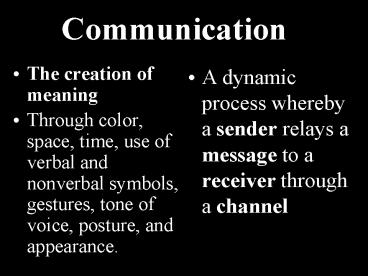Communication - PowerPoint PPT Presentation
1 / 13
Title:
Communication
Description:
Communication The creation of meaning Through color, space, time, use of verbal and nonverbal symbols, gestures, tone of voice, posture, and appearance. – PowerPoint PPT presentation
Number of Views:148
Avg rating:3.0/5.0
Title: Communication
1
Communication
- The creation of meaning
- Through color, space, time, use of verbal and
nonverbal symbols, gestures, tone of voice,
posture, and appearance.
- A dynamic process whereby a sender relays a
message to a receiver through a channel
2
Components Variables of the Communication
Process
Receiver
Sender
Message
Channel
Communication Skills Attitude Knowledge Social
System Culture
Sight Taste Touch Smell Hearing
Content Structure Treatment Code
Communication Skills Attitude Knowledge Social
System Culture
3
Models of Communication
- Linear communication model does not include
feedback. S ? M? C? R - Circular communication model includes feedback
and shows that a comm. Is both sender and
receiver.
M
C
S/R
R/S
4
Barriers to Communication
- Bypassing (misinterpreting symbols/ messages
stimuli) - A. Context (setting where communication occurs)
influences perception and message interpretation - Channel or Medium (the verbal or non verbal
method the sender selects to convey the message).
- A. Possible to send mixed messages
5
Barriers to Communication (Cont.)
- Field of experience
- A. knowledge of subject may differ
- Audience
- A. hostile and does not accept your ideas
- B. passive and does not respond
- C. active and responds readily
- Physical barriers
- A. audience can not see/ hear
6
Communication Situations
- Intrapersonal- talking silently to ones self
- 1. Enables you to think through what you
are going to say - 2. Enables you to organize how youre
going to say it - 3. Enables you to plan to respond to an
opposing idea (counter/ignore the idea)
7
Communication Situations (Cont.)
- Interpersonal- a direct interchange between 2 or
more individuals. Both sender and receiver are
actively involved in communication process using
dialogue. Audience is spontaneous (immediate
feedback)
8
Communication Situations (Cont.)
- Levels of interpersonal
- Phatic communion- consists of clichés and small
talk. Intended to convey very little info. - Reporting facts- person gives facts as he/she
sees them. Response is compared to your own
attitudes and values. - Presenting ideas and opinions- person shares
thoughts and reveals opinions.
9
Communication Situations (Cont.)
- Sharing feelings and emotions- function is to
deal with attitudes about people with whom you
communicate. Expressing appreciation for others
and the things they do for you. - Peak communication a total sharing,
understanding and acceptance of what a person
says. Very rare.
10
C. PUBLIC COMMUNICATIONSpeaker aims at reaching
a larger audience as receivers. Speaker has
little idea who is in the audience and what their
beliefs, values, attitudes are. Audience analysis
is critical.Passive response from audience.
11
D. MASS COMMUNICATIONenables a communicator to
transmit the same message to thousands
simultaneously. Contact with the audience is
indirect. Feedback is in the form of polls,
ratings, surveys. Examples of mass
communicationtv, radio, books, movies,
pamphlets.
12
Improving Comm. Skills
- 1. Be aware of feedback (verbal nonverbal) make
adjustments to make meaning clear and correctly
interpreted by explaining differently, giving
examples, simplifying, or elaborating - 2. Use language that is understood by listeners.
Explain new/unfamiliar words/terms. - 3. Be aware of physical barriers. Speak loud
enough to be heard. Seat audience appropriately
13
- Panel discussion- linear seating
- Group discussion- circular seating
- 4. Take attitude differences into consideration
as you present ideas - 5. Understand your strengths and weaknesses.
Practice listening. - 6. Ask questions































